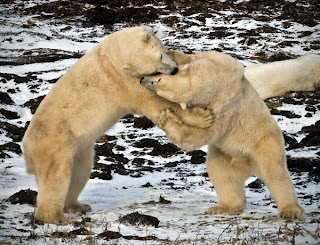 |
| Some birds were harder to photograph than others! |
Dramatic. Beautiful. Unusual. Raw. Unique. Pristine. Isolated. Each of these words holds meaning when you visit the
Galápagos archipelago. There are more than 50 volcanic islands scattered over 4,500 square kilometers on the equator. You are about 1,000 kilometers off of the coast of Ecuador. We had the rare opportunity to visit the
Galápagos Islands from April 22 to 29 on a Road Scholar educational program. These islands are a well-protected National Park of Ecuador, with all visitors required to be with a trained naturalist and no one allowed on land between 6 p.m. and 6 a.m.. We lived on a 118-foot yacht with about 30 other people. Twice each day we would board a dinghy to take us ashore with our naturalist guides for hiking, animal observation, swimming and snorkeling. The isolation of the
Galápagos, as Charles Darwin observed in his famous visit, has permitted life forms to evolve into species found only here. Words are hard to find to describe my experience of this. So I will just let some of my photographs tell the story.
TO VIEW ANY IMAGE LARGER, JUST CLICK ON IT.
All Images Below Copyright by Tom Debley, 2012
All Rights Reserved
Galápagos Whimbrel photographed at a small
lagoon on Isla Floreana.
Galápagos Sea
Lion pup on
the beach at
Gardner Bay,
Isla Española.
A juvenile Galápagos Hawk
came within a few feet,
as curious about us as
we were of him at the
top of a volcanic cinder
cone on Isla Bartolome.
The Lava Heron is a
unique Galápagos
species that made
for an interesting
photograph in flight
on Isla Santiago.
Tortoises, of course,
are synonymous with
the Galápagos Islands.
These images were
captured at different
locales on Isla Santa Cruz.

No set of images would be complete without the Blue-footed Booby, such as this one I photographed on Isla Española.
 |
This Booby is taking off from Isla San Cristobal.
|
Another of the Boobies
in the
Galápagos Islands
is the Nazca Booby,
one seen here perched on
a rock on Isla Española.
A "nursery" of
Nazca Booby chicks
was another thrilling
sight, offering an
chance to see them
from only a few feet
away and for
photographs like this one.
One of the most colorful of all of the critters
in the Galápagos is the Sally Lightfoot Crab.
One of these was among the specimens
collected by Darwin.
 |
| Yellow Flycatcher |
Smaller birds are plentiful, among them the
Galápagos Mocking Bird, which had the greatest influence on Darwin’s theory of
evolution. It was the first species he noticed that had distinct differences from island to
island.
 |
| Yellow Warbler |
 |
| Ground Finch |
 |
| Ground Finch Perched in a Tree |
 |
| Galápagos Mocking Bird |
|
|
|
 |
| Waved Albatross in Flight |
The Waved Albatross, a medium sized albatross with a wing span of seven feet, is among the largest birds we saw. They breed primarily on Isla Española in the
Galápagos archipelago. We were there for mating season.
 |
| Waved Albatross Courting Ritual |
 |
| Waved Albatross Pair Mating |
 |
| Waved Albatross on Her Egg |
A final set of photographs for now is of the every popular Iguanas -- Land, Sea, Lava and Arbor -- found in the tropics of the Galápagos and on the Ecuadorian mainland.
(Special Note: The photograph of me at the top of this blog post was taken by one of our Road Scholar group, Linda Getman. Thanks, Linda!)




























































